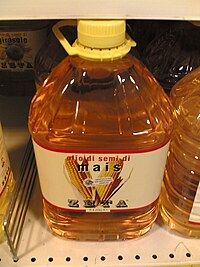
Photo from wikipedia
Volatile organic compounds are important for herbivorous insects in locating their host plants. The rice leaf folder, Cnaphalocrocis medinalis (Guenée), is a devastating migratory insect pest of rice in Asian… Click to show full abstract
Volatile organic compounds are important for herbivorous insects in locating their host plants. The rice leaf folder, Cnaphalocrocis medinalis (Guenée), is a devastating migratory insect pest of rice in Asian countries. Although C. medinalis can develop even better on corn than on rice plants in insectaries, it rarely occurs on corn plants in the field. We hypothesized that plant volatile-mediated oviposition preference for rice over corn in adult females may be the reason for the observed rare field occurrence of the pest on corn plants. The present study was conducted to identify the olfactory active volatile compounds (OAVCs) that enable C. medinalis females to discriminate rice from corn plants. In cage tests, rice plants were highly preferred for oviposition over corn plants by C. medinalis females. From headspace, chemical analyses identified 15 rice unique, 8 corn unique, and 28 common volatile compounds. Fourteen OAVCs, including seven common, five rice unique, and two corn unique, were determined. In electroantennogram tests, the rice unique and common OAVCs activated the antennal responses in C. medinalis. In Y-tube olfactometer tests, (E)-2-hexenal and 3-hexanol(common OAVCs) and (Z)-3-hexenyl acetate and (E)-2-hexen-1-ol (rice unique OAVCs) attracted more C. medinalis females than the control, and only blends with both rice unique and common OAVCs were highly preferred over the control. Our results provide insights into the chemical cues used by C. medinalis adult females in host location, which may aid the development of novel crop protection strategies based on the manipulation of host-finding behaviors of C. medinalis.
Journal Title: Journal of agricultural and food chemistry
Year Published: 2022
Link to full text (if available)
Share on Social Media: Sign Up to like & get
recommendations!